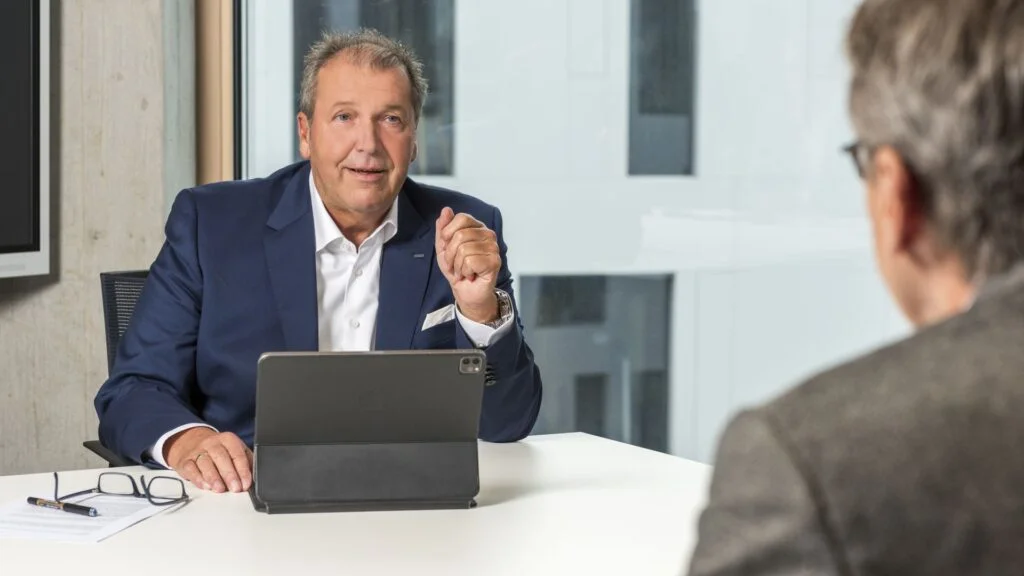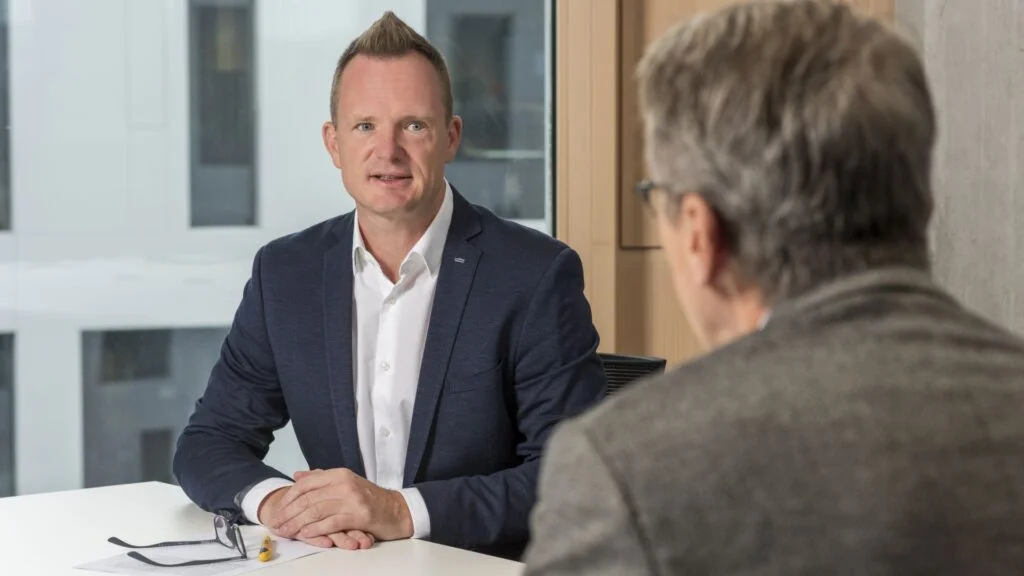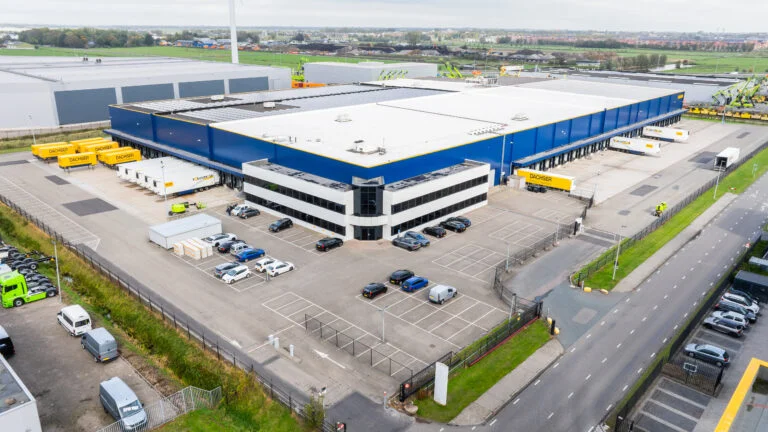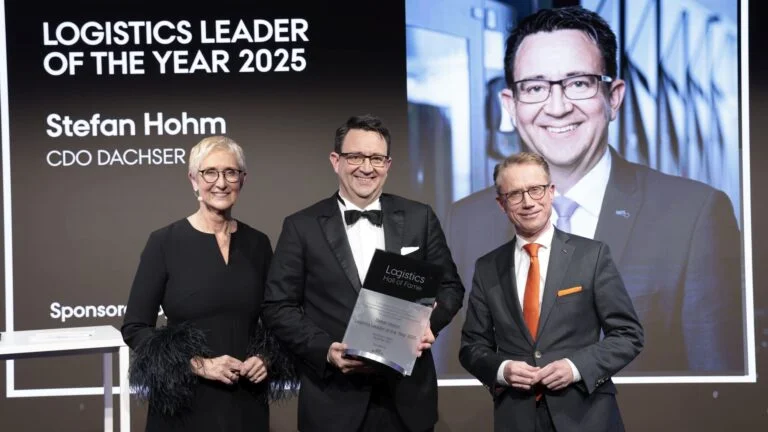Groupage: A battle for scarce capacity looms amid the Christmas rush and promotional business
By Marcus Schick I 10 minute read
31/10/2025
As the recession in Germany continues, its effects can be seen in demand on the transport market. Nevertheless, there’s still tough competition for capacity. What does this mean for the Christmas business? What solutions are available? We talked about these questions and more with Stefan Behrendt, Managing Director Food Logistics, and Andreas Fritsch, Managing Director European Logistics Germany at Dachser.
Quick Read
Germany has been in a recession since 2023; industrial production is declining, which means that less is being transported. Increased price awareness among brand manufacturers is also noticeable in food logistics. What does all this mean for the transport market, which recently has often been highly stressed and overheated?
Andreas Fritsch: If nothing else, I can say there won’t be any relief. This is because the costs of providing high-quality logistics services are increasing. One of the main drivers of that increase is rising personnel costs due to the structural shortage of skilled workers. Added to this are higher costs for materials, such as packaging, as well as in the areas of digitalization, IT, and cybersecurity. Investments in hardware, servers, and licenses are at the top of the logistics agenda.
S. Behrendt: The transport market has its very own dynamics. On the one hand, the base volume in food logistics is declining due to increased price awareness among customers. On the other hand, we’re seeing a significant increase in promotional business, with ever higher peaks. We also have the impression that some senders are taking advantage of the market situation to optimize their own profitability in the short term. However, this is a shortsighted approach, as it amplifies the effect of dwindling resources and—taken together with tougher competition for orders and promotional actions that are difficult to plan—further ramps up the pressure on the transport industry.
A. Fritsch: By contrast, the situation on the driver market has eased somewhat. However, the coronavirus crisis has shown that once drivers have reoriented themselves and moved to other industries, it’s virtually impossible to win them back. That’s why we’re working with our transport partners to maintain long-term capacity in these challenging times.

The overall conditions also have to be right. What role does transport infrastructure play here?
S. Behrendt: It’s become a major challenge for everyone involved in the logistics process. Germany’s aging, dilapidated infrastructure has become a real obstacle in road freight transport. Across the country, thousands of bridges need to be extensively modernized. It feels like the entire federal highway network in Germany is one big construction site. And many major projects are still to come in the next few years as part of the German government’s special infrastructure fund.
A. Fritsch: A look at the figures shows what we and our customers are confronted with on a daily basis. In 2024, over half a million traffic jams were logged, covering some 856,000 kilometers of congestion. That’s more than twice the distance from the earth to the moon. The 448,000 hours spent in traffic jams also have a significant economic impact on transport services. And we haven’t even mentioned the stress this puts on drivers and customers along the supply chain. Take city delivery, for example: Drivers often have problems in urban areas, where they constantly have to deal with new road closures and detours. This also has a business aspect—after all, driving time is working time. And, bearing logistics costs in mind, it’s a resource that we should always plan and use sensibly.
The 448,000 hours spent in traffic jams also have a significant economic impact on transport services.
What does all this mean for Dachser and its transport partners?
A. Fritsch: The only way we can—and must—respond to structural challenges is with foresight and a clear compass. Right now, it’s especially important to make the necessary investments in things like personnel, so that we still have enough cargo space going forward and can keep our promise of quality.
S. Behrendt: The only way we’ll be able to secure capacity in the long term is if we increase our efforts to retain drivers and attract new ones. This will inevitably have to be reflected in remuneration as an aspect of job attractiveness and will thus impact our price and cost structure.
A. Fritsch: It’s precisely this need for job quality and attractiveness in professional driving that DACHSER Service und Ausbildungs GmbH is addressing, by launching comprehensive programs to secure junior staff and improve working conditions. These have been very well received. We now train professional drivers in almost every Dachser branch in German-speaking countries—to work at our company, but above all for their later employment with our service partners and for their transition into self-employment.
S. Behrendt: We know that this alone won’t solve the structural driver shortage that the whole of Europe is struggling with. However, we’re sending a strong signal to the industry as to what a solution could look like. In 2025, 105 young people once again decided to train as professional drivers at Dachser. Their response and the positive feedback from the industry show us that Dachser’s focus on people and respectful cooperation is an important factor in securing supply chains, especially under the particularly challenging conditions of today.
More than ten years ago, the a sustainable training initiative called DACHSER Service und Ausbildungs GmbH was launched to address the shortage of drivers. DACHSER is now one of the largest trainers of professional drivers in Germany.

How can one actively involve the transport partners?
A. Fritsch: We’ve taken several steps to do this, one of them being our service partner initiative. It takes the cooperation between Dachser, the service partners from the transportation companies, and their drivers to a new level. The focus here is on developing long-term collaboration among parties on an equal footing. This is a basic requirement for surmounting the upcoming challenges together on the transport and driver market in the European context. At the same time, it helps us at Dachser to differentiate ourselves from the competition and, together with our service partners, to secure our core business in the long term.
S. Behrendt: The initiative once again makes it very clear: Securing the future is always a joint task; you can’t go it alone. When it comes to, say, the shortage of cargo space, then retailers, manufacturers, and logistics providers are jointly called upon to put in significant effort to make capacity and resources more predictable. The aim must be to act with foresight and flexibility, especially in the event of seasonal fluctuations or promotional offers. Resources such as warehouses, drivers, equipment, etc. and the required (network) quality don’t just fall out of the sky; the costs of maintaining them must be shouldered together by all participants in the supply chain.
A. Fritsch: Forward-looking planning and long-term structural improvement always require that all those involved in the chain be able to react to changes, including at short notice. One example of this concerns packaging material. The current low availability of euro pallets, for example, is causing prices to rise sharply. Such unscheduled price jumps will also have to be reflected in cost calculations.
How do these challenges and the increasing competitive pressure affect Dachser?
S. Behrendt: Smaller freight forwarders in particular are feeling the rising competitive pressure, with margins that are already rather low, and so the number of bankruptcies is rising. One effect of this is consolidation in the logistics sector. It’s primarily large companies such as Dachser that are able to counter price pressure with network efficiency and are thus in a position to tap into new growth opportunities.
What does this mean for food logistics, for example?
S. Behrendt: In the food sector, senders and retailers are under enormous price pressure. Sales are stagnating for branded companies during the recession. Consumers are even more price-conscious in times of uncertainty. At the same time, the pressure on retailers is increasing, with aggressive pricing rounds and increased private label business. Because manufacturers are countering stagnating sales with increasingly intense promotional business, volumes are rising sharply in the short term, and not just during public holidays and major events. All this has to be absorbed by the logistics provider. However, we’re not usually consulted in the course of such planning, a state of affairs that runs counter to our approach of forward-looking, joint action with highly efficient and secure supply chains.
What does that mean specifically?
S. Behrendt: The situation often becomes critical, and not just because the promotional business makes things more difficult to plan. With volumes generally lower due to the recession, fewer available drivers on the market, and less cargo space, it’s difficult to manage the short-term increase in volumes cost-effectively. Especially when customers rightly expect the highest transport quality and reliability.
In a special Christmas edition of the German DACHSER podcast “NetzWert,” DACHSER’s Food Logistics experts explain how treats get onto supermarket shelves in time for the holidays.
Are you expecting delivery bottlenecks at Christmas? Are we in for unpleasant surprises under the Christmas tree and on the festive dinner table at home?
A. Fritsch: At Dachser, we’re well prepared for the Christmas rush and promotional business and have an efficient, robust network with decades of experience. This enables us to maintain appropriate capacity for our customers. However, it takes considerable effort on our part and involves a lot of preparation in network management. In view of the increasing cost pressure, securing the supply chain from manufacturer to market in good time and in a predictable manner for the holiday season comes at a price. It requires joint efforts by manufacturers, retailers, and logistics providers to optimize costs.
S. Behrendt: However, some senders see things differently. The weak overall economic situation has led logistics providers to increasingly offer available capacity to producers in the food sector for non-temperature-controlled transportation. This may fill gaps in the short term, but it does nothing to advance a sustainable recovery in the availability of either personnel or cargo space.
With personnel and material costs expected to continue rising, massive investments are required to secure capacity in the long term—and to be able to offer customers efficient and high-quality logistics services.
What happens next? Is there any relief in sight?
A. Fritsch: Freight volumes on the road actually recovered somewhat at the beginning of 2025, especially in France, Poland, and Germany. Nevertheless, they’re still lower than in the first quarter of 2024. We expect a slight recovery, because inflation is easing off and the mood in industry and among consumers is slowly brightening.
S. Behrendt: But one other thing is true: With personnel and material costs expected to continue rising, massive investments are required to secure capacity in the long term—and to be able to offer customers efficient and high-quality logistics services. It turns out that Dachser was right to go with the strategy and targets it laid out years ago. While many other companies are slowing to a cautious crawl, we’re sticking to our long-term goals and continuing to build on network advantages, efficiency, and quality. That means we won’t be restricting our range of services; on the contrary, we’ll continue to expand them with centralized and decentralized network planning, modern locations, IT and AI expertise, and qualified employees. A lot of things have to come together to achieve our level of network quality, which is unique on the market and offers the best possible reliability.
A. Fritsch: Already today, we’re thinking about tomorrow and the day after tomorrow. For Dachser, state-of-the-art vehicles and alternative powertrain systems play a key role. In certain urban areas, emission-free deliveries with e-trucks or cargo bikes are standard for us. DACHSER Emission-Free Delivery will cover 25 European cities by the end of 2025. All of this is geared toward the future and to customer satisfaction; that means it’s so much more than just a knee-jerk, crisis-mode response of offering bargains that often turn out to be anything but.






